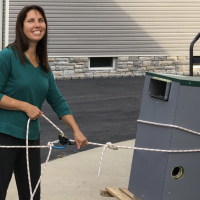Steam Boiler swap savings
Trying to get an idea of how much I’d save switching to a smaller boiler. House has 2,500sqft of finished space (1,300 1st fl, 700 2nd fl, and 500 attic) from 1920’s in Northeast PA. The current boiler is a 2022 New Yorker CGS80C which looks to be 199k BTU’s. My current annual heating cost is about $4,000. I went and measured the individual radiators and the total edr came to 612. This converted to 147,000 BTU’s. So wondering if my calculations are correct and how much money I’d save switching to a smaller sized steam boiler?
Comments
-
-
Your current boiler is sized for 621 EDR. That’s a close match to your connected heating load. Better air vents on the steam mains and pipe insulation if you currently don’t have it are your only options for better efficiency boiler wise.
https://www.ecomfort.com/manuals/14fe6c73de2838c1d67edaf112b992ed.pdf
3 -
What @Waher said above. Much the best way to save. However, you should also check the pressure settings at which the boiler is operating. in most "normal" two pipe and all one pipe systems, the boiler pressure control should be set to cutout at between 1.5 and 2.0 psig, and cut back in at 1 psig lower. Any pressure higher than that is not helping your heating, but is burning fuel to no purpose.
Also check your main venting — if that is lacking, it may take longer than needed for steam to reach the radiators and do something useful.
Br. Jamie, osb
Building superintendent/caretaker, 7200 sq. ft. historic house museum with dependencies in New England2 -
-
Don’t dismiss the fine points of dialing in your steam heat’s operation. I’ll add to the consensus that Getting control of the pressure and assuring you have good venting is really where big savings can be had. I would add that you should confirm the boiler is piped to the instructions provided with the boiler (at minimum) and that it was properly skimmed when installed. The latter two points are important for production of “dry” steam. Dry Steam carries few water droplets with it, providing maximum efficiency in heat transfer. Wet steam is heavy and wastes energy.
Regarding target pressure, it might be worthwhile to understand what variety of steam system you have. The reason I mention this is that if yours is a two pipe vapor system and you’re running more than several ounces of pressure you’re bound to be wasting energy.
For example, if I shut off half my radiators and allow the pressure to rise to 3psi, the cycle length is almost as long as it is with all the radiators open but at much lower pressure. It’s not hard to see that one could spike fuel use tremendously if the pressure is too high for the task at hand. There is such a thing as a Vaporstat that is like your boiler’s pressuretrol but it’s calibrated in ounces. It may be worth investigating.
A steam heating system out of calibration can be an energy hog. One that’s dialed in should be very economical to run, all other things being equal. Obviously heat loss is the other half of the picture. But start with confirming optimum steam system operation since it’s on your mind alreadyTerry T
steam; proportioned minitube; trapless; jet pump return; vac vent. New Yorker CGS30C
1 -
Hello QuintonS,
Unless you are choking off your radiators with TRVs or something else is wrong with your system, with your boiler at 621 Sq. Ft. and your total EDR is 612 you should not have any pressure issues, since the radiation is 98.6 % of the boiler output the radiation should dissipate most all of what the boiler can give it. By the time the pressure starts to creep up (if it ever does) the thermostat will probably be satisfied. A smaller boiler would just run longer to keep the house comfortable, so the fuel cost would probably be about the same. The money could probably be better spent improving the home to reduce the heat loss. And as was stated above, make sure your main venting is adequate.
National - U.S. Gas Boiler 45+ Years Old
Steam 300 SQ. FT. - EDR 347
One Pipe System1
Categories
- All Categories
- 87.3K THE MAIN WALL
- 3.2K A-C, Heat Pumps & Refrigeration
- 61 Biomass
- 427 Carbon Monoxide Awareness
- 119 Chimneys & Flues
- 2.1K Domestic Hot Water
- 5.8K Gas Heating
- 114 Geothermal
- 165 Indoor-Air Quality
- 3.7K Oil Heating
- 76 Pipe Deterioration
- 1K Plumbing
- 6.5K Radiant Heating
- 395 Solar
- 15.6K Strictly Steam
- 3.4K Thermostats and Controls
- 56 Water Quality
- 51 Industry Classes
- 50 Job Opportunities
- 18 Recall Announcements





